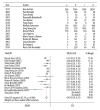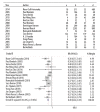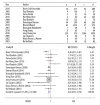Effects of Exercise-Based Cardiac Rehabilitation in Patients with Acute Coronary Syndrome: A Meta-Analysis
- PMID: 31280281
- PMCID: PMC6636406
- DOI: 10.12659/MSM.917362
Effects of Exercise-Based Cardiac Rehabilitation in Patients with Acute Coronary Syndrome: A Meta-Analysis
Abstract
BACKGROUND Acute coronary syndrome (ACS) has become an important cause of death from cardiovascular disease. Cardiac rehabilitation (CR) plays an essential role in ACS patients after treatment. Therefore, in order to detect the impact of CR on mortality and major adverse cardiac events in patients with ACS, we conducted this meta-analysis. MATERIAL AND METHODS We searched PubMed, Web of science, and EMBASE databases to obtain published research results from 2010 to August 2018 to determine the relevant research. Random-effects model or fixed-effects model were used to calculate relative risk (RR) and 95% confidence interval (CI). RESULTS Overall, a total of 25 studies with 55 035 participants were summarized in our meta-analysis. The results indicated that the hazard ratio (HR) of mortality significantly lower in the CR group than in the non-CR group (HR=-0.47; 95% CI=(-0.56 to -0.39; P<0.05). Fourteen studies on mortality rate showed exercise was associated with reduced cardiac death rates (RR=0.40; 95% CI=0.30 to 0.53; P<0.05). We found the risk of major adverse cardiac events (MACE) was lower in the rehabilitation group (RR=0.49; 95% CI=0.44 to 0.55; P<0.05). In 11 articles on CR including 8098 participants, the benefit in the CR group was greater than in the control group concerning revascularization (RR=0.69, 95% CI: 0.53 to 0.88; P=0.003). The recurrence rate of MI was reported in 13 studies, and the risk was lower in the CR group (RR=0.63, 95% CI: 0.57-0.70; P<0.05). CONCLUSIONS Our meta-analysis results suggest that CR is clearly associated with reductions in cardiac mortality, recurrence of MI, repeated PCI, CABG, and restenosis.
Conflict of interest statement
None.
Figures










References
-
- Mansencal N, Pillieere R, N’Guetta R, et al. Characteristics and prognosis of coronary revascularization procedure in patients age 80 and older presenting with acute myocardial infarction. Med Sci Monit. 2010;16(1):CR15–20. - PubMed
-
- Widimsky P, Crea F, Binder RK, Luscher TF. The year in cardiology 2018: Acute coronary syndromes. Eur Heart J. 2019;40(3):271–82. - PubMed
-
- Antman EM. Time is muscle: Translation into practice. J Am Coll Cardiol. 2008;52(15):1216–21. - PubMed
-
- Ibanez B, James S, Agewall S, et al. 2017 ESC Guidelines for the management of acute myocardial infarction in patients presenting with ST-segment elevation: The Task Force for the management of acute myocardial infarction in patients presenting with ST-segment elevation of the European Society of Cardiology (ESC) Eur Heart J. 2018;39(2):119–77. - PubMed
Publication types
MeSH terms
LinkOut - more resources
Full Text Sources
Medical
Miscellaneous

